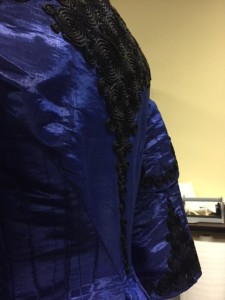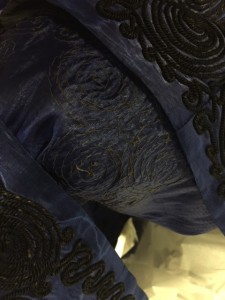M.S. Ridgely and the Blue Dress
The process for pulling dresses from the Pratt House is really quite adventurous and fun. The boxes are usually picked by random, so going through the chosen boxes once they’re out of Pratt House is a feeling similar to opening presents each day, a surprised in every box. A particular dress caught all of our interests from the first day; we peeked in the box and decided to save it as a treat for getting through the first week of the project. When we finally removed the dress from the box, it did not disappoint.
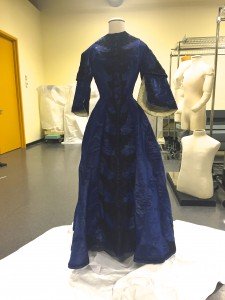 1956.15.47 Visiting dress worn by Mrs. Margaretta Sophia Howard Ridgely (ca. 1870s).The Estate of Miss Eliza Ridgely. View of the front of dress
1956.15.47 Visiting dress worn by Mrs. Margaretta Sophia Howard Ridgely (ca. 1870s).The Estate of Miss Eliza Ridgely. View of the front of dress 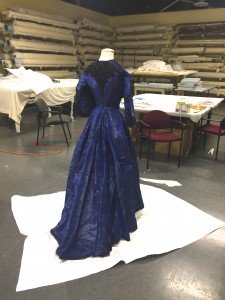 1956.15.47 Visiting dress worn by Mrs. Margaretta Sophia Howard Ridgely (ca. 1870s). The Estate of Miss Eliza Ridgely. View of the back of dress
1956.15.47 Visiting dress worn by Mrs. Margaretta Sophia Howard Ridgely (ca. 1870s). The Estate of Miss Eliza Ridgely. View of the back of dress
The blue dress, as we affectionately call it, is a wonderful, deep, electric blue made of watered silk faille poplin with black cording throughout. The entirely hand-stitched gown is still in amazing condition. The dress was most likely a visiting dress, which was only worn inside the house to meet and greet guests. Despite its remarkable condition for it's age, it would need slight conservation if it is ever to be displayed, as the back waist seam is a bit loose. We delved into the provenance for the dress and found that the donor is a descendant of the Ridgely family of the Hampton National Historical Site, and that the wearer was Mrs. Margaretta Sophia Howard Ridgely.
The Ridgely’s were a very prominent family in Maryland dating back to the Revolutionary War. The family had many War Generals, Captains, and a Colonel throughout their history. While the family presents a multitude of research opportunities, this particular post will revolve around Margaretta Sophia and her beautiful blue dress.
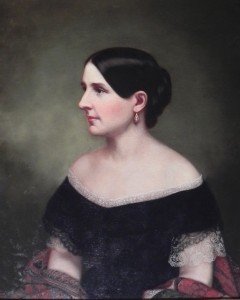 Margaretta Sophia Howard, by Lily Pollock of Baltimore, (1870). Photo courtesy of Gregory Weidman, Hampton House.
Margaretta Sophia Howard, by Lily Pollock of Baltimore, (1870). Photo courtesy of Gregory Weidman, Hampton House. Margaretta Sophia Howard was born in 1824 to parents James Howard and Sophia Gogh Ridgely. Her father was the son of Gen. John Eager Howard who commanded Maryland troops during the Revolutionary War. Her mother, Sophia, was the daughter of Charles Ridgely who was the Governor of Maryland from 1815 to 1818. Margaretta Sophia was of a sweet character and incredible beauty; she was even crowned “Queen of Beauty” at the wedding of her sister, Juliana Elizabeth Howard. Margaretta Sophia married Charles Ridgely (her mother, Sophia’s, nephew) in 1851. They had eight children, seven of which lived to adulthood. The family lived at the Hampton Mansion in Towson, Maryland (now a National Historic Site) until after the Civil War. Charles and Margaretta Sophia sent their sons to Europe to be educated, then followed them there in the summer of 1870. Her husband unfortunately contracted typhoid fever on his travel to Rome and died in 1872, making Margaretta a widow at the age of 48. Margaretta took care of the family estate upon their return to Maryland, and was known as a kind and gracious hostess. She continued to manage the estate until her death in 1904.
According to Gregory Weidman, curator of the Hampton National Historic Site, the dress was possibly purchased in London or France in 1870, and only worn a few times before her husband's death in 1872. After Charles’s death, Margaretta Sophia went into mourning and exclusively wore black until her own death. This is potentially why the dress is in such fantastic condition.
Margaretta Sophia led an interesting and fulfilling life, which can only be expressed now through her written history and possessions. This aesthetic blue dress is a reminder of how much costume can tell us and help us understand a persons’ history; we can have a connection to the person that supersedes portraiture and historical research. Costume can ignite a familiarity within the viewer because of the intimate association clothing has with the body, and what it tells us about the wearer. Margaretta Sophia Howard Ridgely has a story, and her beautiful blue dress was able to tell part of it.
—————————
A special thanks to Leo Witt, an intern at MdHS for his fantastic research on Margaretta Sophia and the Ridgely family.
And to Gregory R. Weidman, curator of the Hampton National Historic Site, for giving me more information about M.S. Ridgely and providing the wonderful portrait of her in this post. Please read more about the Hampton House in the link below.
Hampton National Historic Site


